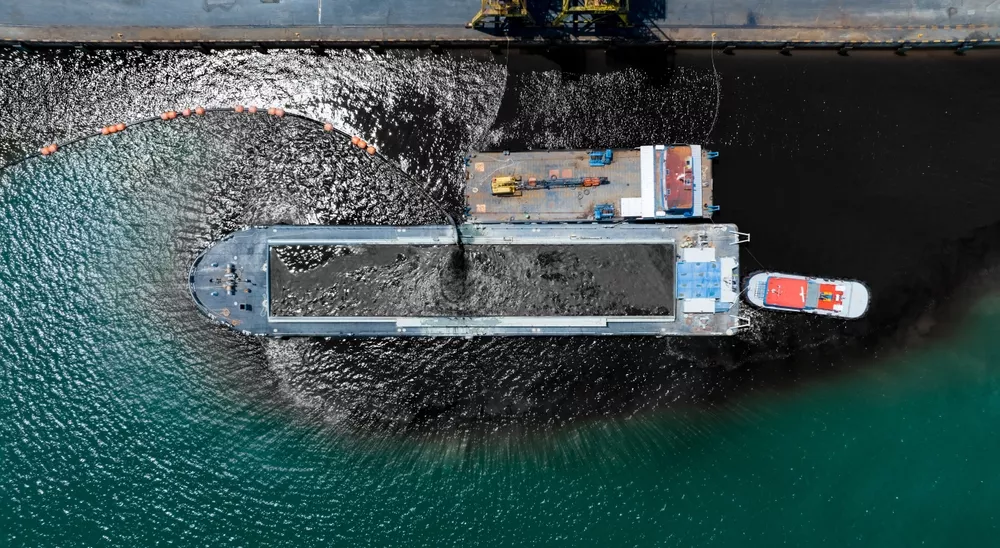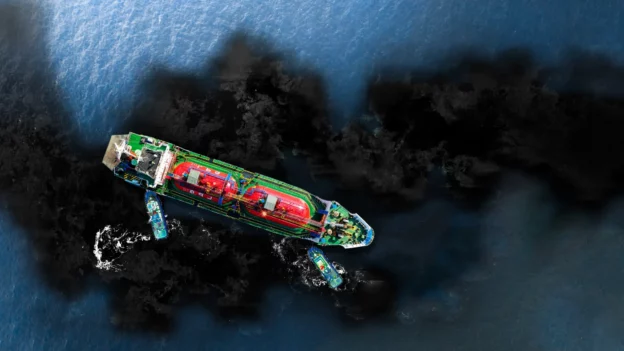Table of Contents
- What is emergency oil spill response?
- Design and operation of emergency oil spill response systems
- Legal requirements in emergency oil spill response
- Equipment and technologies used in rapid spill response systems
- The importance of emergency oil spill response: Lessons from Deepwater Horizon
- Conclusions
- References
Oil spills pose a serious threat to marine ecosystems, unleashing a series of devastating effects that can last for weeks or even months if rapid and effective containment and cleanup measures are not taken. In the face of these imminent dangers, it is crucial to have rapid spill response systems in place to contain and clean up oil accumulations, thus mitigating their devastating impact on marine ecosystems and human health.
As activities such as offshore oil exploration and extraction continue to expand, the likelihood of future spills increases exponentially. As a result, emergency oil spill response is needed to mitigate and reduce these unfortunate events that pose a danger to marine life and the offshore industry.
What is emergency oil spill response?

This refers to the set of planning and response mechanisms that enable facility owners or operators to effectively manage oil spills. These mechanisms are composed of a plan that includes the commitment of workers, equipment and protocol documentation necessary for protection against spills1. Additionally, these types of systems have inspection or surveillance programs to detect failures and/or spills, in order to ensure early detection and timely response.
In the offshore sector, emergency oil spill response is crucial for spill prevention and environmental protection, since the protocols ensure efficient and effective emergency management, ideal for reducing the impact of oil spills. The implementation of such contingency plans allows a rapid mobilization of human and technical resources, ensuring an immediate and coordinated response for the optimal development of containment operations.
Design and operation of emergency oil spill response systems
The design and operation of emergency oil spill response systems is structured in several critical phases, each with a specific focus to ensure ideal preparedness and response. The main stages are:
Definition of the scope of a contingency plan
This phase involves the creation of a robust preparedness and response framework that considers corporate guidelines and legislation at local and national levels1. This stage relies on stakeholder identification and consultation to ensure that the plan adequately reflects their needs and requirements.
Development of spill scenarios
It involves the exhaustive analysis of the possible risks and events that the response systems may experience. The importance of this phase is that it helps to identify the most critical planning scenarios, including worst-case scenarios1. Once the risk analysis of the possible scenarios has been carried out, the response strategies are developed, which are divided into strategic and tactical response plans.
Finally, the necessary response capacity is determined, and from there the rapid spill response systems are created, which must be reviewed and updated periodically to incorporate any changes in risks or in the regulatory framework.
Design of strategic and tactical response plans
Strategic and tactical response plans enable effective management of the initial and ongoing phases of an oil spill. In addition to ensuring compliance with regulatory requirements, they detail the actions to be taken during the first 0-48 hours of an incident (reactive mode) and for longer responses (proactive mode). The main features of each of these plans are presented below:
Strategic response plan
Describes medium and long-term incident response management objectives2. It provides detailed information beneficial to decision-makers, focusing on overall strategies to achieve desired spill protection outcomes. Key components of these plans include planning scenarios, selection of response strategies based on Net Environmental Benefit Analysis (NEBA), and input from subject matter experts.
Tactical response plan
Its specialty is to provide operational information to execute selected response techniques, covering aspects such as deployment methods, equipment limitations, logistics and other operational considerations2. Key elements include specific specialized plans (protocols focused on shoreline assessment, wildlife protection, etc.), personnel requirements, deployment methods and equipment operation.
It also addresses general response information such as health and safety guidelines, communications and documentation requirements. This type of plan ensures the practical execution of selected responses, with detailed instructions for mobilizing resources, deploying equipment and maintaining previously established operational conditions.
Response systems are designed to adapt to the specific circumstances of each incident, thus allowing essential flexibility in addressing various possible scenarios. Their integration into the national and international response infrastructure enhances the ability to protect waters and shorelines from the adverse effects of oil spills.
Legal requirements in emergency oil spill response
Oil spill response is governed by a series of federal legal requirements designed to ensure that both workers and the environment are protected during emergencies. Every facility or vessel at risk of spills must have an Oil Spill Response Plan (OSRP), which details the number of workers needed, their qualifications, and the procedures to follow during a spill. The plan also specifies the availability of response resources, including equipment, supplies, and trained personnel, whether owned or contracted .
Employers must comply with OSHA’s Hazardous Waste Operations and Emergency Response (HAZWOPER) standard (29 CFR 1910.120 and 1926.65) when workers are exposed to hazardous substances. This standard requires employers to create comprehensive safety and health programs, including site-specific health and safety plans, emergency response plans, exposure monitoring, and training.
Additionally, the National Oil and Hazardous Substances Pollution Contingency Plan (NCP) mandates that response actions follow HAZWOPER provisions (40 CFR 300.150). These regulations extend to both private-sector employees and state or local government responders, who are covered either by OSHA-approved State Plans or the EPA’s HAZWOPER standard (40 CFR 311).
Equipment and technologies used in rapid spill response systems
Skimmers
They are designed to eliminate floating spills on the surface of the water and are therefore considered to be very useful spill protection equipment. Depending on their design, these spill response equipment can use various technologies, such as conveyor belts, skimming or gravity technologies, to collect the spilled oil in tanks for processing and recovery. Due to their principle of operation, they are recommended for use in still water, as these conditions are where they are most effective3.
Autonomous underwater vehicles (AUVs)
These are robotic devices used in the assessment and management of oil spills. They can be rapidly deployed once a spill is identified, with the aim of providing near real-time information through a secure interface. Autonomous underwater vehicles allow large volumes of data to be collected continuously, surpassing the capability of traditional methods, such as data collection via manned vessels.
Thanks to integrated sensors, AUVs detect oil in water, helping to further assess dispersions. Because they require little training to set up, they are useful tools for rapid spill response systems.
Drones and satellites
Although technological advances have allowed the development of better safety protocols for marine spills, there are still limitations that represent obstacles in the framework of protection against spills. Some of the biggest challenges are related to the difficulty of accessing certain areas, as well as determining the degree of expansion of the spill.
In response to such issues, monitoring technologies such as drones and satellites are of great help. These devices can provide real-time data on spills occurring over considerable distances, which would enable the implementation of more effective and efficient emergency oil spill response.
Spill mapping and remote spill detection have become extremely important tools for spill containment, as they offer the opportunity to study in depth the characteristics of these unfortunate events and act on them.
The importance of emergency oil spill response: Lessons from Deepwater Horizon
The Deepwater Horizon oil spill of April 20, 2010, remains one of the starkest reminders of why emergency oil spill response is essential. When the offshore drilling rig exploded in the Gulf of Mexico, it killed eleven workers and released nearly four million barrels of oil into the sea over eighty-seven days. This catastrophic event became the largest marine oil drilling spill in history.
The disaster revealed how the absence of swift, coordinated, and effective emergency response magnifies human, environmental, and economic losses. Beyond the immediate tragedy of lives lost, the uncontrolled spill devastated ecosystems, harmed fisheries, and disrupted coastal economies across the Gulf.
This tragedy demonstrated that emergency response to an oil spill is not optional, but rather the first line of defense against knock-on effects. Preparedness ensures that spills are quickly contained, human lives are protected, environmental damage is minimized, and companies remain compliant with strict legal standards.
Conclusions
Offshore operations, such as offshore oil extraction, ship to ship transfers, among others, are essential processes in the value chain of the oil and gas industry. However, these operations have a high degree of sensitivity due to the potential disasters that may occur in the event of any mishap.
One of the most common disasters are spills, which endanger the sea and the fauna found in such ecosystem. Therefore,emergency oil spill response is a solution to this problem that affects the world, and also the integrity of the oil industry.
These protocols are specifically designed to contain and mitigate the possible scenarios that can trigger a spill. To this end, a combination of documents and equipment and technologies are used to ensure protection against spills at sea.
Considering that the world is in the process of ensuring sustainability in all sectors, it is necessary for offshore operations to have such operational standards, since by implementing the practices defined in these systems, offshore operations will not pose any danger to these ecosystems.
References
- Short, L. y Tindell, R. (2023, July 20). An Introduction To Contingency Planning For Oil Spills. Retrieved May 15, 2024, from https://www.oilspillresponse.com/es/centro-de-conocimiento/Planificaci_46n-de-contingencias/an-introduction-to-contingency-planning-for-oil-spills/
- Oil Spill Response. (n.d.). Strategic and Tactical Planning. Retrieved May 15, 2024, from https://www.oilspillresponse.com/globalassets/technical-library/information-sheets/technical-information-sheet–strategic-and-tactical-planning.pdf
- Environmental Protection Agency (EPA). (n.d.). Skimmers. Retrieved May 17, 2024, from https://www.epa.gov/emergency-response/skimmers

